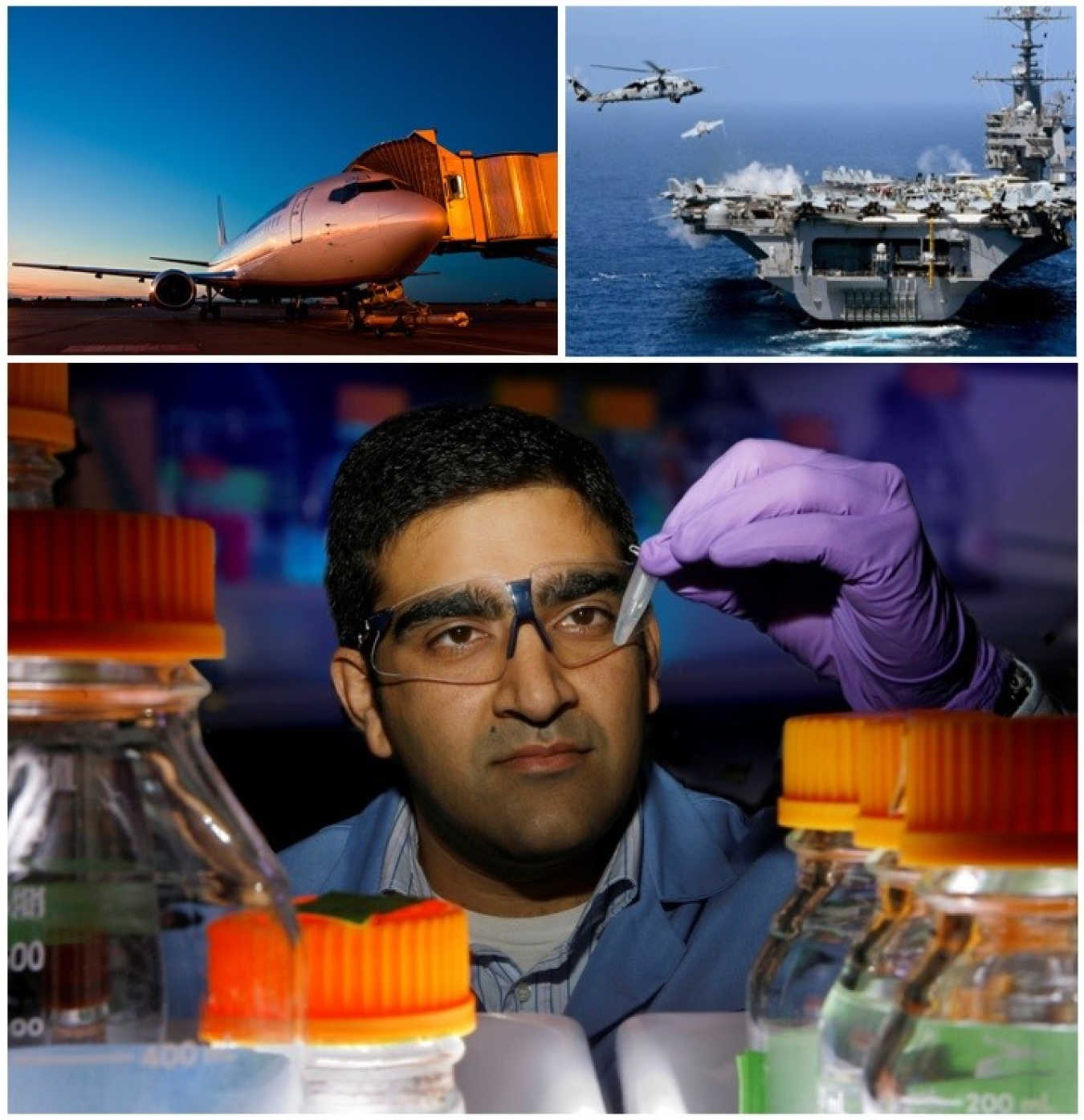A large part of the solution to reducing greenhouse gas emissions in the transportation sector could be uniquely filled by biofuels and bioproducts.
Office of Energy Efficiency & Renewable Energy
August 24, 2016
From top left: A commercial airplane, a Navy aircraft carrier, and a researcher. Commercial aviation, the U.S. military, and organic waste streams are all compelling opportunities for biofuel.
A large part of the solution to reducing greenhouse gas emissions in the transportation sector could be uniquely filled by biofuels and bioproducts. The Energy Department’s Bioenergy Technologies Office (BETO), in partnership with the national laboratories, academia, and private companies, is pursuing biofuel research and development to reduce greenhouse gas emissions and secure our energy independence. During our ninth annual bioenergy conference (Bioenergy 2016), we heard from many leaders in the field of bioenergy who presented compelling reasons for why cost-competitive biofuels are needed outside of on-road transportation. Among them were Julie Felgar, managing director of environmental strategy at Boeing; Dennis McGinn, assistant secretary of the Navy, Energy Installations & Environment; and Congresswoman Marcy Kaptur of Ohio.
So, who needs biofuels? Here is what these three illustrative, distinguished leaders said (paraphrased):
Commercial airlines (Julie Felgar)
Eight years ago, leading aircraft manufacturer Boeing strategized about how it could continue to grow its business without growing greenhouse emissions at the same rate. Electrification was not an option for many reasons, including that electricity does not provide enough thrust to get a large airplane off the ground. Boeing looked to biofuels. Boeing has now tested and approved five biofuel pathways through the ASTM (American Society of the International Association for Testing and Materials) process. Today, routine flights are powered by biofuels, but Felgar said the key to widespread market penetration is to lower the cost of these fuels even more. These biofuels are actually better for airplanes to run on since they have fewer contaminants, and there may be opportunities where renewable jet fuel has a higher energy density than petroleum fuel. She said airlines around the world are ready and able to take on sustainable aviation biofuels as soon as they are cost competitive.
The Navy (Dennis McGinn)
The U.S. military is the largest single consumer of oil in the world. Its mission success depends on getting ships, airplanes, and combat vehicles promptly to where they need to be. Their success is affected by energy availability and how often their vehicles need to refuel. Using energy efficiently can result in more power to equip naval forces, deter aggression, and protect U.S. interests. McGinn said that with biofuel, the Navy can reduce its dependence on just one energy source (oil) and lower its greenhouse gas emissions while using its existing vehicle fleet. Watch this video for more information.
Communities with waste stream concerns (Congresswoman Marcy Kaptur)
Producing biofuel can help alleviate crucial environmental and public health problems facing some of our communities. Rep. Kaptur of Ohio encouraged bioenergy leaders to develop waste-to-energy technology solutions to help take advantage of wet waste as resources for biofuels—thereby, turning waste into a resource.
BETO is helping to fund projects that reduce the cost of renewable jet fuel, that scale up biorefineries to produce biofuel for commercial and military use, and that improve the efficiency and reduce risks of innovative technologies that convert wet waste to biofuel. In addition, BETO is holding an alternative aviation fuel workshop in September to convene aviation industry stakeholders to advance the understanding of the barriers to price competitiveness of commercial aviation biofuels.
Biofuels could be commercialized for commercial aviation and the military more quickly than for vehicles on the road. Over the past 10 years, these sectors have been working to develop, evaluate, and deploy biofuels. Five different types of renewable aviation fuels have been approved by ASTM since 2009. In the past year, renewable fuel producers, airlines, and the military have signed several fuel purchase agreements. However, alternative fuels are still not price-competitive enough to meet the needs of the aviation industry and the military, and that is where BETO’s research and development efforts play an important role. BETO also plays a significant part in developing waste-to-energy technologies, which is new to our office’s portfolio.
What is clear is that sectors beyond on-road transportation have a need for biofuels.
- A large part of the solution to reducing greenhouse gas emissions in the transportation sector could be uniquely filled by biofuels and bioproducts.
- Today routine flights are powered by biofuels. Biofuels are actually better for airplanes to run on since they have fewer contaminants. Airlines around the world are ready and able to take on sustainable aviation biofuels as soon as they are cost competitive.
- With biofuels, the Navy can reduce its dependence on just one energy source (oil) and lower its greenhouse gas emissions while using its existing vehicle fleet.
- Five different types of renewable aviation fuels have been approved by ASTM since 2009. In the past year, renewable fuel producers, airlines, and the military have signed several fuel purchase agreements.

